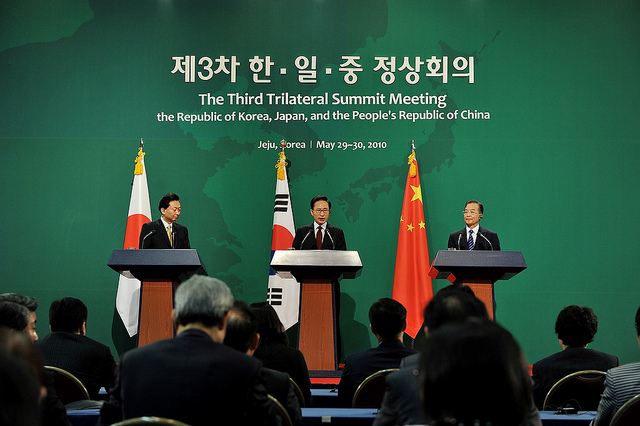While much of the attention in global summitry has been on the informal G20 “high table”, not unreasonably, there has been architectural action elsewhere in global summitry that warrants examination.
For “IR wonks” – needless to say I am one – the focus since the 2008 global financial crisis has been on global transformation. The US is declining – at least relatively – so the argument goes. The unquestioned US hegemonic leader since the end of World War II – is increasingly debated and many have suggested that the end of its global leadership. As a result there has been a spate of articles that suggest a new architectural configuration – see Charlie Kupchan’s in “No One’s World” or Ian Bremmer’s “Every Nation for Itself: Winners and Loser in a G-Zero World” And the defense from oa number of US policymakers of ‘Leading from Behind” has done little to maintain confidence in continuing US hegemonic leadership.
The attention has passed to others – most particularly on the newly rising states -especially on China. The rise of the BRICS leaves analysts focused on the power transformation notwithstanding that even the rising powers have shown signs of economic unrest including economic slowdown.
But what has gone largely unnoticed by the IR cognoscenti has been the building “from below” of a number of what traditionally have been called regional alliances – I shall come back to to defining exactly what a regional alliance is or is not. Now it is true that there has been some attention paid to the negotiation of the TPP – or TransPacific Partnership. Now the original 9 members (Australia, Brunei, Chile, Malaysia, Peru, Singapore, Vietnam and the United States) represent a rather “motley crew” of Asia and Pacific states – driven primarily by the United States. Noticeably the members negotiating this “21st century trade arrangement” include not a single major Asian economy – notwithstanding that Japan has expressed some interest in joining the negotiations. On that one don’t hold your breathe. Even with the addition presumably of Mexico and Canada – it remains a US creation targeting China. If any of the big four – China, Indonesia, Japan or Korea – were to join then we would be looking at a far more significant trade and even political-economic entity. Then we’d look at the relationship more closely.
Barring that, however, there is already something worth take serious note of in Asia. This is the Japan-China-Republic of Korea (ROK) Trilateral Summit. This summit is an outgrowth of the APT or ASEAN plus three – the three again being China, Japan and ROK. Now the three released a joint statement in May from their fifth summit. Yup the first having occurred in 2008. So the “Big Three” having been holding summits since 2008 but a “thick” transgovernmental network of ministerial meetings have been going on much longer – trade and investment ministers, finance officials, agriculture officials, disaster relief officials more recently. In September last year the Big Three established a Trilateral Cooperation Secretariat in Seoul. And the Big Three recently congratulated themselves on signing an investment agreement (The Trilateral Agreement for the Promotion, Facilitation and Protection of Investment) and they have agreed to launch an FTA negotiation with in the year. Also the Big Three have paid close attention and have urged the strengthening of the Chiang Mai Initiatives Multilateralization (CMIM) – suggesting that the Initiative be doubled in size and enlarging the IMF de-linked portion and also introducing a crisis prevention function. The Big Three have also welcomed the start of the surveillance activities of the ASEAN + 3 Macroeconomic Research Office (AMRO).
The focus on finance and economics mark this summit as an important element in global summitry. Though a regional gathering these three states have strong global influence and the gathering represents a significant – if unheralded part – of global summitry.
So while this trilateral relationship builds a stronger economic relationship, what of the security dimension? Until now the key multilateral setting has been the 6-Party talks. Some of seen the 6-Party gathering as the first glimmering of at least closer east asian security relations – especially in light of the failure of Australia’s APc – or Asia-Pacific Community started by then Prime Minister Kevin Rudd. But the 6-Party gathering has been stalled for some time due to strong conflict driven from the US- North Korea (DPRK) stalemate over the DPRK’s nuclear and missile programs.
Meanwhile, the ROK and Japan sought to enhance bilateral security relations in building a wider security architecture. But creating these relations have foundered just recently over the continuing sensitivity between Japan and Korea, especially for the Korean population – retaining long memory of Japan’s colonization of Korea in the 20th century. This sensitivity led the current Korean administration to carry out discussions secretly. The secret effort negotiated and approved a pact to share confidential military data concerning the DPRK – a step to a closer relationship urged by Washington. The public and the Korean Parliament were only advised of this limited step on the presumed date of signing and as a result a top Korean foreign policy expert, Kim Tae-hyo was forced to resign.
Thus building and not-building a new architecture in Asia.
Image Credit: Third Japan-China-ROK Trilateral Summit – Korea.net


